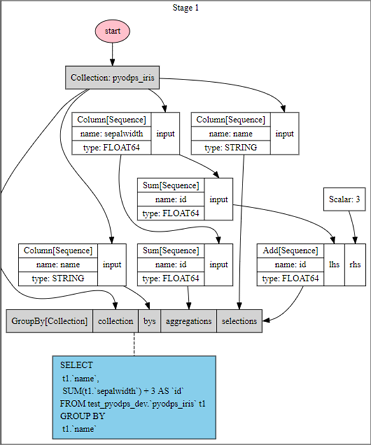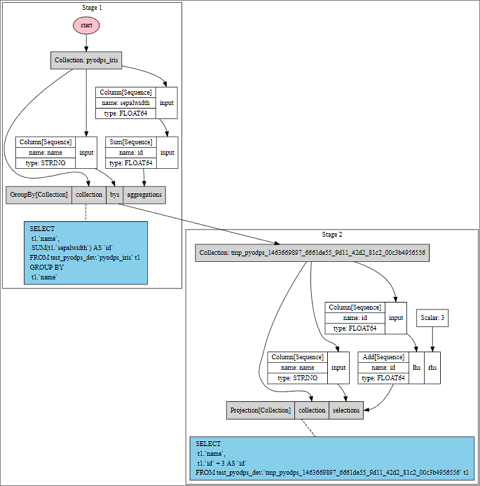Alibaba Cloud MaxCompute SDK for Python (PyODPS) DataFrame optimizes the execution process of each operation. You can use the visualization feature to display the entire computation process.
DataFrame visualization
DataFrame visualization depends on graphviz and the graphviz package for Python. 
>>> df = iris.groupby('name').agg(id=iris.sepalwidth.sum())
>>> df = df[df.name, df.id + 3]
>>> df.visualize()
The computation process shows that PyODPS DataFrame combines the  The entire execution process runs in two steps because a cache operation is performed.
The entire execution process runs in two steps because a cache operation is performed.
groupby operation and the column filtering operation. >>> df = iris.groupby('name').agg(id=iris.sepalwidth.sum()).cache()
>>> df2 = df[df.name, df.id + 3]
>>> df2.visualize() The entire execution process runs in two steps because a cache operation is performed.
The entire execution process runs in two steps because a cache operation is performed.
View compiled results at the MaxCompute SQL backend
Call the
compile method to view compiled results of SQL statements at the MaxCompute SQL backend.
>>> df = iris.groupby('name').agg(sepalwidth=iris.sepalwidth.max())
>>> df.compile()
Stage 1:
SQL compiled:
SELECT
t1.`name`,
MAX(t1.`sepalwidth`) AS `sepalwidth`
FROM test_pyodps_dev.`pyodps_iris` t1
GROUP BY
t1.`name`Perform local debugging by using the pandas computation backend
If you use MaxCompute tables as the sources for DataFrame objects, the system does
not compile or perform some operations at the MaxCompute SQL backend. Instead, the
system uses the MaxCompute Tunnel service to download data. This way, the system does
not need to wait for the MaxCompute SQL backend to schedule download tasks. This allows
you to download small amounts of data from MaxCompute to a local directory and use
the pandas computation backend to compile and debug code. You can perform the following
debugging operations:
- Select all or some rows of data from a non-partitioned table, or filter the column data, and then calculate the number of specified rows. The column filtering operation does not compute column values.
- Select all or some rows of data from all or the first several partition columns that are specified in a partitioned table, or filter the column data, and then calculate the number of the specified rows.
Assume that the
iris DataFrame object uses a non-partitioned MaxCompute table as the source. The following
operation uses the MaxCompute Tunnel service to download data: >>> iris.count()
>>> iris['name', 'sepalwidth'][:10]Assume that the DataFrame object uses a partitioned table that includes the ds, hh, and mm partition fields. The following operation uses the MaxCompute Tunnel service to download
data:
>>> df[:10]
>>> df[df.ds == '20160808']['f0', 'f1']
>>> df[(df.ds == '20160808') & (df.hh == 3)][:10]
>>> df[(df.ds == '20160808') & (df.hh == 3) & (df.mm == 15)]In this case, you can use the to_pandas method to download the data to a local directory for debugging.
>>> DEBUG = True
>>> if DEBUG:
>>> df = iris[:100].to_pandas(wrap=True)
>>> else:
>>> df = irisAt the end of compiling, set DEBUG to False to complete computation on MaxCompute.
Note Some programs that pass local debugging may fail to run on MaxCompute because of the
limits of the sandbox.